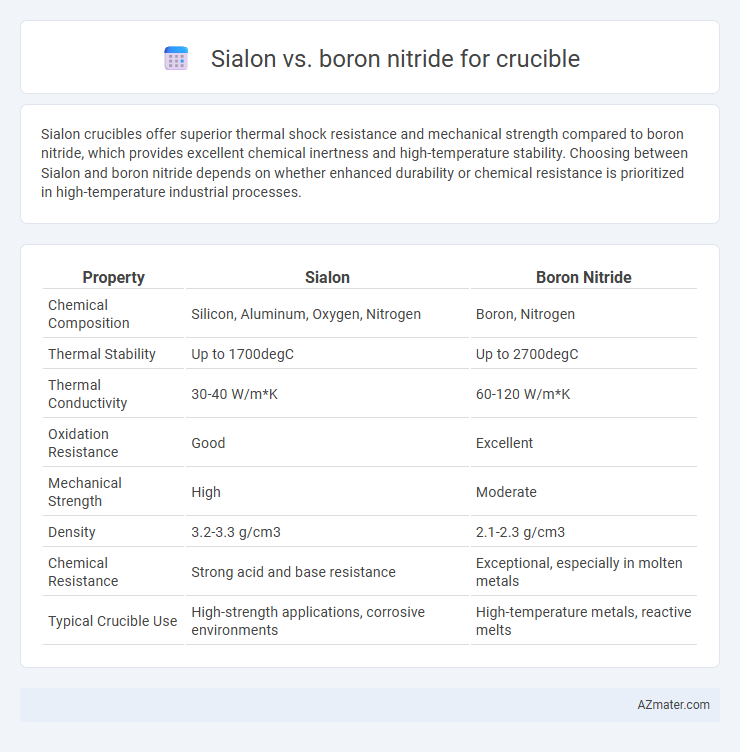Sialon crucibles offer superior thermal shock resistance and mechanical strength compared to boron nitride, which provides excellent chemical inertness and high-temperature stability. Choosing between Sialon and boron nitride depends on whether enhanced durability or chemical resistance is prioritized in high-temperature industrial processes.
Table of Comparison
| Property | Sialon | Boron Nitride |
|---|---|---|
| Chemical Composition | Silicon, Aluminum, Oxygen, Nitrogen | Boron, Nitrogen |
| Thermal Stability | Up to 1700degC | Up to 2700degC |
| Thermal Conductivity | 30-40 W/m*K | 60-120 W/m*K |
| Oxidation Resistance | Good | Excellent |
| Mechanical Strength | High | Moderate |
| Density | 3.2-3.3 g/cm3 | 2.1-2.3 g/cm3 |
| Chemical Resistance | Strong acid and base resistance | Exceptional, especially in molten metals |
| Typical Crucible Use | High-strength applications, corrosive environments | High-temperature metals, reactive melts |
Introduction to Sialon and Boron Nitride Crucibles
Sialon crucibles are advanced ceramic containers composed of silicon, aluminum, oxygen, and nitrogen, renowned for their exceptional thermal shock resistance, chemical stability, and mechanical strength at high temperatures. Boron nitride crucibles exhibit outstanding chemical inertness, excellent thermal conductivity, and resistance to thermal shock, making them ideal for handling reactive molten metals and corrosive environments. Both materials serve critical roles in high-temperature industrial processes, with Sialon favored for robust mechanical performance and Boron nitride prized for its chemical purity and thermal management.
Material Composition and Structure Comparison
Sialon crucibles consist of silicon, aluminum, oxygen, and nitrogen, forming a dense, covalently bonded ceramic matrix with exceptional thermal shock resistance and mechanical strength. Boron nitride crucibles, composed primarily of hexagonal boron nitride (h-BN), feature a layered structure analogous to graphite, offering excellent chemical inertness, high thermal conductivity, and resistance to thermal shock at elevated temperatures. The covalent bonding in sialon provides superior structural rigidity, while the laminar structure of boron nitride ensures enhanced lubricity and oxidation resistance under harsh chemical environments.
Thermal Stability and Heat Resistance
Sialon crucibles offer excellent thermal stability with continuous use temperatures up to 1600degC, making them suitable for high-temperature applications requiring both mechanical strength and oxidation resistance. Boron nitride crucibles exhibit superior heat resistance, maintaining structural integrity at temperatures exceeding 2000degC while providing exceptional thermal shock resistance and chemical inertness. The choice between Sialon and boron nitride depends on specific thermal requirements, where Sialon excels in high-strength environments and boron nitride dominates in ultra-high temperature conditions and chemical stability.
Chemical Resistance in Aggressive Environments
Sialon crucibles exhibit superior chemical resistance in aggressive environments due to their strong covalent bonding and dense microstructure, making them highly resistant to oxidation and corrosion by molten metals and slags. Boron nitride crucibles offer excellent chemical inertness, particularly against strong acids and alkalis, but can degrade under high-temperature oxidative conditions. Selecting between Sialon and boron nitride depends on the specific chemical environment and thermal stability requirements of the crucible application.
Mechanical Strength and Durability
Sialon crucibles exhibit superior mechanical strength due to their silicon, aluminum, and oxygen-based ceramic composition, which provides excellent fracture toughness and resistance to thermal shock. Boron nitride crucibles offer outstanding thermal stability and chemical inertness but generally have lower mechanical strength and can be more prone to cracking under mechanical stress. The enhanced durability of Sialon makes it ideal for high-stress applications, while boron nitride's softness favors processes requiring non-wetting surfaces and low reactivity.
Thermal Shock Resistance and Performance
Sialon crucibles exhibit superior thermal shock resistance compared to boron nitride, enduring rapid temperature changes without cracking due to their high fracture toughness and thermal shock resilience. Boron nitride offers excellent thermal conductivity and chemical inertness but is more prone to thermal shock failure under sudden thermal cycling. Sialon's enhanced mechanical strength and structural stability make it the preferred choice for high-temperature applications requiring robust thermal shock performance.
Cost-Effectiveness and Economic Considerations
Sialon crucibles offer superior cost-effectiveness compared to boron nitride due to their lower raw material costs and enhanced durability, reducing replacement frequency in high-temperature applications. Boron nitride crucibles, while providing excellent thermal shock resistance and chemical inertness, incur higher upfront expenses and may necessitate more frequent replacement, impacting overall economic efficiency. Choosing Sialon balances performance with budget constraints, making it a preferred option for industries prioritizing long-term economic benefits.
Suitability for Various Industrial Applications
Sialon crucibles offer exceptional wear resistance and thermal stability, making them ideal for molten metal handling in steel and aluminum industries. Boron nitride crucibles provide superior chemical inertness and excellent thermal shock resistance, suitable for semiconductor and chemical processing applications. The choice between Sialon and Boron nitride hinges on the specific industrial environment, with Sialon favored for high abrasion and temperature scenarios, while Boron nitride excels in environments requiring minimal chemical interaction and rapid temperature changes.
Maintenance, Lifespan, and Replacement Frequency
Sialon crucibles exhibit superior resistance to thermal shock and chemical corrosion compared to boron nitride, resulting in longer lifespans and reduced maintenance requirements in high-temperature applications. Boron nitride crucibles, while offering excellent thermal conductivity and inertness, tend to degrade faster under aggressive thermal cycling, necessitating more frequent replacements. The enhanced durability of Sialon reduces downtime and operational costs by minimizing maintenance interventions and extending overall crucible usage intervals.
Choosing the Right Crucible: Sialon vs Boron Nitride
Choosing the right crucible depends on application-specific thermal and chemical requirements; Sialon crucibles offer exceptional mechanical strength and thermal shock resistance ideal for high-temperature metal processing, while Boron Nitride crucibles excel in chemical inertness and thermal conductivity, suited for semiconductor and ultra-pure material fabrication. Sialon's superior fracture toughness makes it preferable for environments with rapid temperature fluctuations, whereas Boron Nitride's non-wetting surface prevents contamination in reactive melts. Evaluating compatibility with the melting material, temperature range, and contamination risks ensures optimal crucible performance and longevity.

Infographic: Sialon vs Boron nitride for Crucible
 azmater.com
azmater.com